Detailed description of how to clean the iron from scale and carbon deposits at home and by special means
 Any iron, regardless of cost and manufacturer, requires careful handling and regular maintenance during operation.
Any iron, regardless of cost and manufacturer, requires careful handling and regular maintenance during operation.
The main causes of faulty operation of an electric appliance are the formation of lime deposits and the appearance of carbon deposits on the soleplate.
Limescale clogs the steam outlet holes and leaves white streaks on fabrics during ironing.
Scaling is caused by regular use of untreated tap water.
Limescale builds up when the temperature is not correct, the appliance is left on for long periods of time, and synthetic fabrics are overheated. Contamination impairs the iron's slip, provokes stains and damage to clothing during ironing.
Contents
- Soiling on the iron soleplate
- Features of soleplate materials
- soleplate materials
- Iron soleplate cleaning with special products
- Iron soleplate cleaning with local remedies
- Using a special liquid to rid the inside of the iron of limescale
- Iron self-cleaning function
- Precautions for cleaning your iron with various products
- Preventing the soiling of your iron
- Useful Videos
Carbon deposits on the soleplate of the iron
There are many causes for the appearance of soot scum:
- Improper observance of the temperature regime, as a result of which fabric fibers stick to the overheated soleplate. More often than not, fouling forms when an overheated appliance comes into contact with synthetic materials. Burnt fabric forms black stains on the soleplate.
- When the hot soleplate comes into contact with buttons and other elements made of plastic. When exposed to high temperatures, a small amount of melted plastic sticks to the appliance.
- Mechanical damage to the soleplate. Contact with metal parts during ironing and dropping the appliance on a hard surface provoke the appearance of defects on the coating of the soleplate, resulting in the accumulation of small particles of fabric, dirt and dust in places of damage.
- Improper contact with lining materials is accompanied by glue on the sole, which turns into soot during subsequent heating.
- Hard lime water can cause not only scale, but also fouling. When escaping through the special holes on the soleplate, the scale remains on the sliding surface in small quantities and burns.
- Dust accumulates on the surface if there is no cleaning. The formation of fouling occurs when a dirty iron is switched on.
- Incorrect ironing of things with prints. The contact of the hot iron and the figure, spoils not only the application itself, but also the soleplate of the electric device, to which dyes adhere.
 Features of soleplate materials
Features of soleplate materials
When choosing an iron, special attention is paid to the soleplate, because it is this part of the electrical device is responsible for effective smoothing and preserving the fabric.
The main criteria for selecting the soleplate:
- Uniform gliding. The iron should move freely over the fabric, without feeling obstructed, requiring no special pressure.
- Smoothing. The device should easily cope with creases, without leaving damage or traces on the fabric.
- Uniform heating. The temperature should be the same on all surfaces of the soleplate.
- Durability. It is better to give preference to materials that are resistant to mechanical damage.
- Ease of use. The presence of non-stick coating will greatly facilitate the use of the iron.
Materials of the soleplate
 Ceramic
Ceramic
Pure ceramic soleplate is not made, due to the fragility of the material. For the manufacture of ceramic soleplate, a mixture with the addition of chromium and nickel is used, and steel or aluminum is used as a base. Pure ceramic is coated on the top layer, for easier sliding.
Pros:
- good glide;
- smoothing the fabric without creases and folds;
- easy cleaning;
- low cost.
Cons:
- Short-lived material.
 Metal-ceramic
Metal-ceramic
The composition can include various alloys, most often stainless steel, which makes the soleplate more durable than ceramic.
Pros:
- Ease of gliding regardless of fabric structure;
- easy care;
- affordable price.
Cons:
- susceptibility of the coating to mechanical damage.
 Aluminum
Aluminum
Plastic metal has recently become actively used for the manufacture of working surfaces of irons. The main reason for its popularity is the affordable price of the material.
Pros:
- rapid heating and cooling, due to the high thermal conductivity of the metal;
- easy sliding;
- small weight.
Cons:
- Exposure to surface scratches;
- The absence of a special coating in inexpensive models of irons.
 Stainless Steel
Stainless Steel
The stainless steel soleplate has become widespread because of its resistance to damage and the possibility of long-term use.
Pros:
- good slip;
- impervious to mechanical impacts;
- resistance to corrosion;
- uniform heating of the surface.
Cons:
- heavy weight.
 Teflon
Teflon
Only the top layer of the soleplate is coated with Teflon, while aluminum or steel is used as the base. Teflon non-stick coating provides easy gliding and efficient smoothing of even stale creases.
Pros:
- Protection of the fabric from the adverse effects of high temperatures;
- easy cleaning;
- good contact with the fabric.
Cons:
- Scratch-resistant results in reduced nonstick properties.
 Composite materials
Composite materials
The composite soleplate is made of several components with different properties, which gives it greater durability. One of the main advantages - no damage when in contact with metal elements.
Pros:
- easy slip;
- high strength;
- resistance to mechanical influences.
Cons: None detected.
 Titanium
Titanium
Titanium soleplate appeared relatively recently and combined some characteristics of aluminum and stainless steel. The result is a lightweight and reliable product.
Pros:
- Uniform heating;
- rapid sliding;
- resistance to chemical attack;
- resistance to mechanical influences;
- Temperature retention over a long period of time.
Cons:
- high cost of the iron.
Cleaning the soleplate of your iron with special products
Products for removing dirt from the iron can be purchased at almost any retail outlets. Special products easily and effectively clean the surface of the soleplate without damaging the coating.
 Pencil
Pencil
A means for cleaning the soleplate is a small-sized device with a solid structure, which leaves a trace when in contact with the surface. The main mass of pencils has in its composition - ammonia alcohol, which is the main cleaning ingredient.
Method of application:
- make the iron heated to 150 ° C in an upright position;
- Cover the dirty surface evenly with the pencil without getting into the holes for steam escape;
- wait until the soleplate has cooled down;
- Remove the cleaner together with a cotton or linen cloth.
The dirt will disappear with the melted product.
 Melamine sponge.
Melamine sponge.
Sponges can be used to remove both fresh and stale dirt. The product is multifunctional - it can also be used to clean appliances or utensils. However, the sponge is not suitable for the soleplate with a non-stick layer, as it can damage the surface.
How to use:
- moisten the sponge with water;
- lightly rub the surface until the dirt disappears;
- After cleaning, wipe the soleplate with a dry cloth.
 Cleaning mat for the soleplate
Cleaning mat for the soleplate
The mat for cleaning the worktop is a relatively new product. The product has a small size (slightly larger than the size of the iron), cleaning pile, some models provide a special retainer to prevent slipping on flat surfaces.
How to use:
- place the mat on a table or ironing board;
- Use the cold sole of the iron to go over the mat fluff several times;
- Wipe the cleaned surface with a damp cloth;
- Steam clean the rug itself.
 Liquid cleaners
Liquid cleaners
Liquids for cleaning are selected for each type of coating individually. Therefore, before buying, it is necessary to familiarize yourself in detail with the intended use of the product.
Such solutions cope with different types of dirt, as well as cover the surface of the iron invisible protective film that prevents the appearance of carbon deposits.
How to use:
- Spread the liquid in an even layer on the surface of the soleplate;
- Wait for 3 minutes;
- Wipe the surface with a moist rag, and then wipe with a dry cloth.
If you can't remove the soot the first time, you can repeat the process.
Cleaning the soleplate of the iron with improvised means
In cases where there is no possibility to buy special products, you can use folk recipes for cleaning. There are several common compounds, with the help of which the iron soleplate will regain its pristine appearance. However, before using a particular method, you should consider the compatibility of the composition with the type of coating of the soleplate.
 Soda and salt
Soda and salt
Method 1.
A handful of salt should be placed in gauze rolled up in several layers and tied tightly. The lightly heated iron should be wiped with gauze until the fouling is completely removed.
Method 2.
It is necessary to cover a smooth surface with a waffle towel, put salt on top (1 handful is enough) and move the hot iron over it, i.e. do the standard ironing. In the process of cleaning salt will begin to stick together and take on a darker shade. This is a sign that cleaning is almost complete.
Method 3.
Soda is mixed with water in a 2/1 ratio, to the consistency of a thick porridge. Next, the composition should be applied to a soft napkin, rub the soot, wait 10 minutes and rub again. After cleaning, the remains of the baking soda should be removed with a dry cloth made of natural fiber.
The water in the composition can be replaced with a dish detergent. It should be noted that cleaning with baking soda is done only on a cold surface.
 Toothpaste and tooth powder
Toothpaste and tooth powder
Non-abrasive toothpaste and tooth powder are suitable for all iron surfaces. They are great for cleaning the soleplate without leaving damage.
The toothpaste or powder is applied to the soiling and, using a toothbrush, cleans the surface until the soot is completely removed. After cleaning, wipe the soleplate with a damp and then a dry cloth.
There is another way: cover the dirt with a layer of toothpaste, heat the iron, and then remove the paste along with the dirt.
Hydrogen Peroxide
To remove stale soot from the soleplate, you should take a small piece of cloth or absorbent cotton, soak in a 3% hydrogen peroxide solution, and wipe the problem areas. The iron during processing should be cold. This method removes even hopeless dirt.
 Acetone and nail polish remover
Acetone and nail polish remover
With acetone or nail polish remover, you can get rid not only of carbon deposits, but also of melted polyethylene stuck to the soleplate. For cleaning, a nail polish remover marked "acetone-free" is also suitable.
To remove the dirt, take a piece of absorbent cotton or any natural cloth, soak it in the liquid and wipe the dirty areas.
 Vinegar
Vinegar
There are a lot of options for removing soot with the help of acetic acid. In any case, for the procedure it is necessary to choose a well-ventilated roomTo avoid the negative effects of vinegar fumes and an unpleasant acrid smell.
Option 1
- Mix 2 tablespoons of vinegar in a glass of water;
- Soak a cotton swab or a piece of natural fibre cloth in the solution obtained;
- Wipe heated soles with the solution.
Variant 2
- soak a piece of cloth in vinegar;
- Place the iron on the cloth in a horizontal position, leave it overnight;
- In the morning wash the surface with soap and then clean water;
- In the morning wash the surface with soap and then clean water; wipe it with a dry cloth.
 Ammonia
Ammonia
Cleaning with ammonia should also be done in a room with good ventilation.
Method 1
- Heat an iron;
- Wet an unwanted cloth or tissue with ammonia;
- spread it out on a smooth surface;
- Iron with the iron, pressing the soleplate on the cloth;
- Continue the procedure until the fouling is completely removed.
Method 2
- Apply ammonia alcohol to the problem areas of cold soles;
- leave it on until morning;
- In the morning, wipe the sole with a dry cloth.
 Laundry soap
Laundry soap
Using laundry soap can remove only minor fresh dirt. To remove stale soot, this tool is not suitable.
How to use:
- Wipe the soles with a damp cloth, wipe dry;
- Dissolve 1 tbsp. soap shavings in a small amount of warm water;
- The resulting mixture applied to a slightly heated sole;
- Leave for 20 minutes, until the sole cools down;
- hardened soap mass wash off with a wet sponge.
The paraffin is removed along with the hardened soap mass.
 Paraffin
Paraffin
The work surface, on which the remaining product will drip, should be covered with newspaper or other unnecessary material. During the cleaning process, care should be taken to ensure that the steam holes and relief elements do not become clogged with paraffin. If the product does get into the recesses, it must be removed to avoid ruining the clothes during ironing.
How to use:
- Wrap the paraffin candle with a cloth to make it more comfortable to hold;
- Heat the sole plate to the maximum;
- stroke the surface with the tip of the candle;
- Wait until the sole is completely cooled down;
- Carefully remove cured paraffin, wipe the surface with a cloth.
 Clearing scale inside the iron with a special liquid
Clearing scale inside the iron with a special liquid
The most effective agents for cleaning from scale are considered products made in Germany. Special chemical cleaners have in their composition organic elements and substances that resist corrosion.
How to use:
- Prepare a solution of 3 parts water and 1 part cleaner;
- Pour the solution into the tank;
- Heat the iron to the maximum temperature;
- Turn off the iron, place it on the stand in a horizontal position;
- Leave it for the time specified in the instructions (depending on the type of product and the desired effect, the time can vary from 10 minutes to 2 hours);
- pour out the liquid and rinse the iron several times with filtered water, using the steam release button;
- After all the limescale has come out of the iron, wipe the surface with a dry cloth.
- Check the cleanliness of the iron before ironing by steam ejection.
 Iron self-cleaning function
Iron self-cleaning function
The iron's self-cleaning or "self clean" function automatically removes internal soiling and limescale deposits. The self clean button is most often located next to the steam button, but each model has a specific location. First of all, you need to read the instructions for the iron.
How to use the function:
- make a solution of 50% distilled water and pour into the liquid compartment;
- set the temperature to maximum, turn on the device;
- prepare a container for the contaminated liquid to come out of the iron;
- after the temperature reaches maximum, turn off the iron and press the self-cleaning button;
- Shake the iron periodically so that the impurities separate better from the walls of the appliance;
- The soleplate is intensively heated during cleaning, so utmost care should be taken.
Certain models have anti-lime rods, which are treated separately, by soaking in a special agent. Soaking time is up to 5 hours. After the time has elapsed, the parts are rinsed with clean running water.
 Precautions for cleaning the iron with various products
Precautions for cleaning the iron with various products
Removing soot from the iron
- Do not immerse the iron in water or other liquids.
- When cleaning, keep the iron only in an upright position.
- If the cleaning process requires a long time, it is better to place the appliance on a damp cloth.
- It is strictly forbidden to get cleaning agents into the steam outlet holes, as the liquid may cause the wires to short out.
Descaling
In the process of descaling, the soleplate is strongly heated, and the process of cooling the surface takes a long time. Therefore, do not touch the soleplate with your hands, Do not touch the soleplate with your hands as this may cause burns.
 Prevent your iron from getting dirty
Prevent your iron from getting dirty
- Always pour water out of the compartment when you have finished ironing.
- Remove dirt from the soleplate surface in good time.
- Dilute hard water with distilled water at a 1/1 ratio.
- Clean the steam outlet holes in time with a special product.
- Clean the self-cleaning function of the iron on a monthly basis.
- Choose the correct temperature for each type of fabric.
- Iron only clean garments, as dust from worn garments can get caught in the holes and scratch the surface.
- Wool garments should only be ironed over damp gauze.
- Each time you finish, wipe the surface of the soleplate with a dry cloth.
- Carefully study the instructions after purchasing an electric appliance.
Useful Video
In this video you will learn how to clean your iron at home:



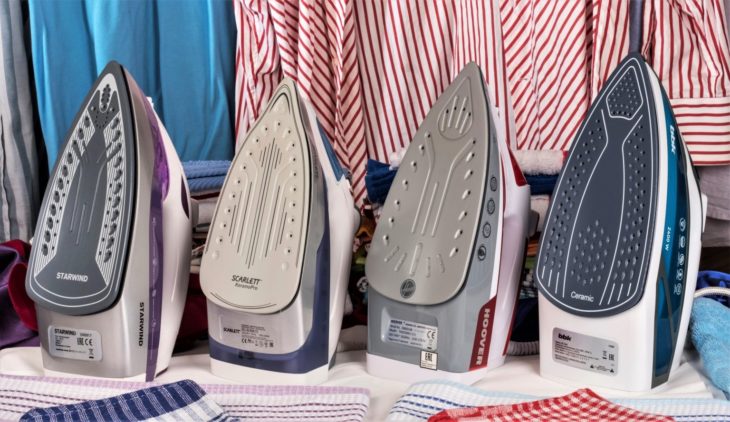 Features of soleplate materials
Features of soleplate materials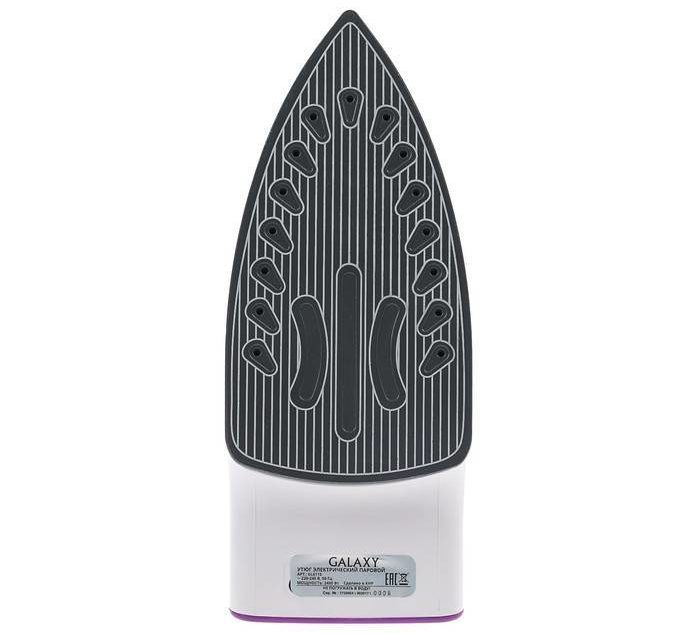 Ceramic
Ceramic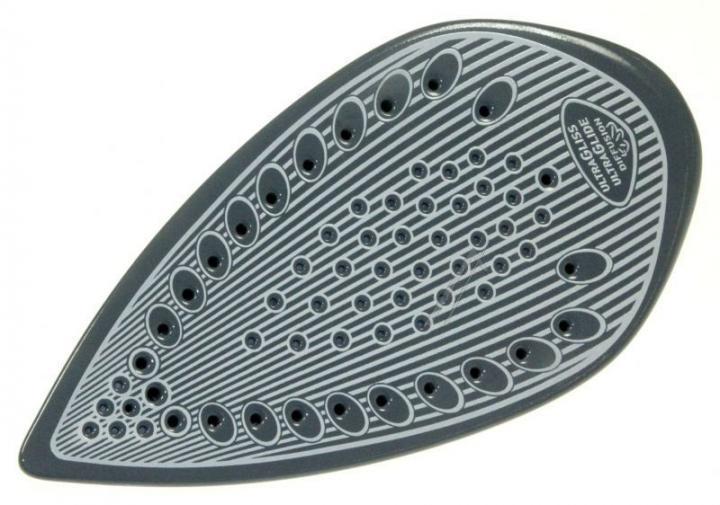 Metal-ceramic
Metal-ceramic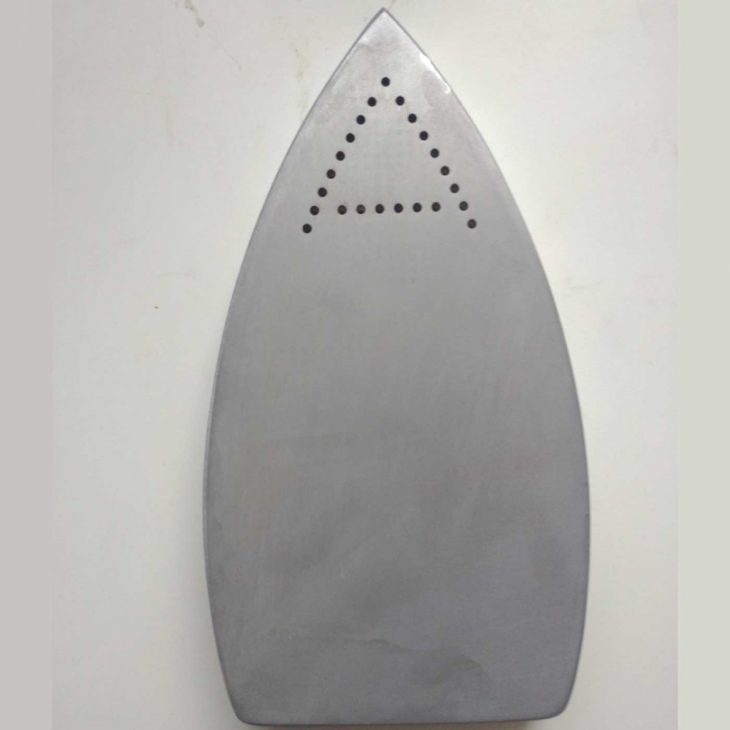 Aluminum
Aluminum Stainless Steel
Stainless Steel Teflon
Teflon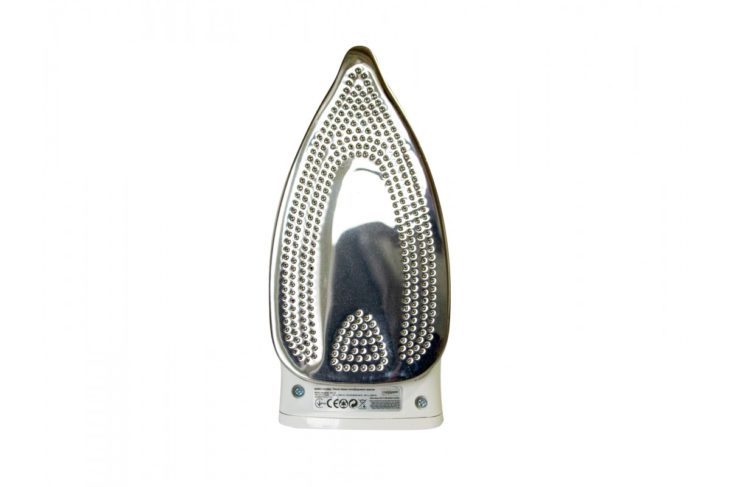 Composite materials
Composite materials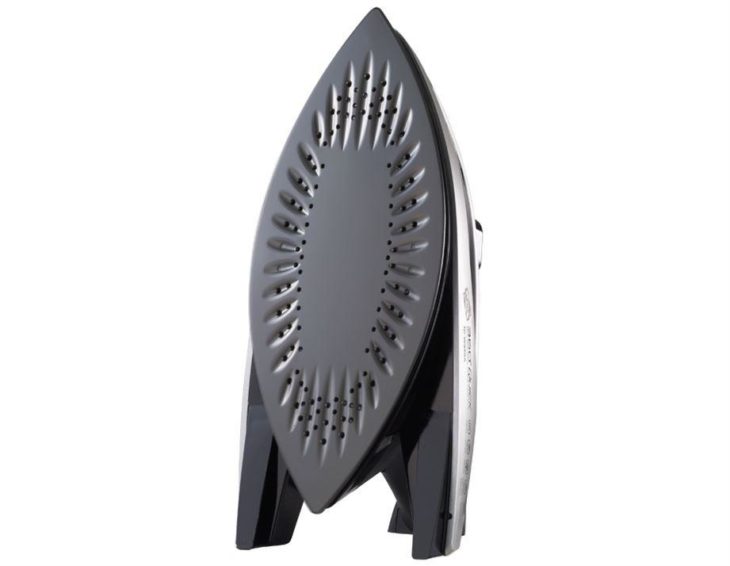 Titanium
Titanium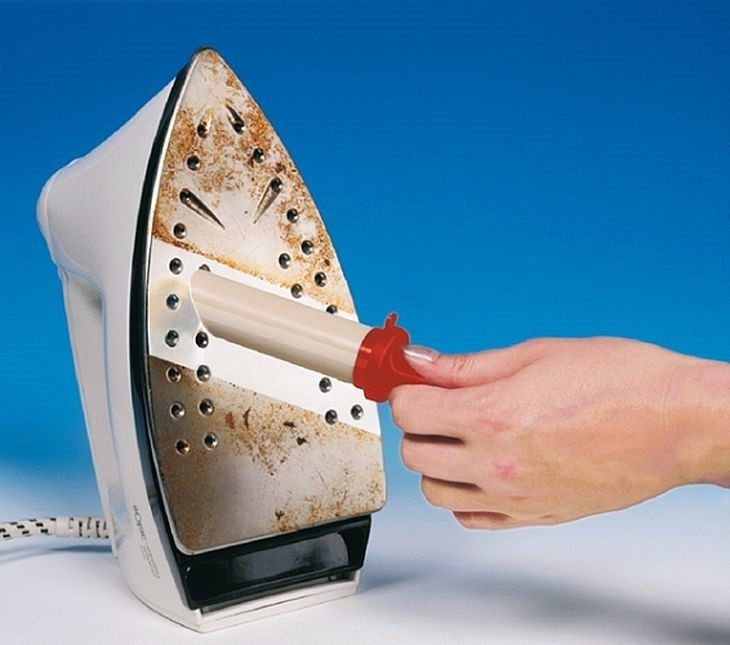 Pencil
Pencil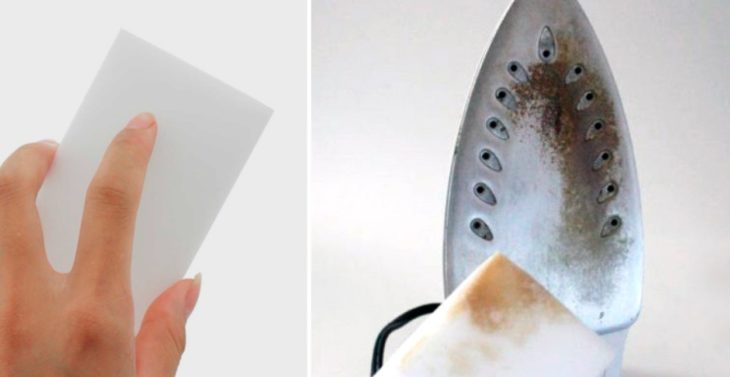 Melamine sponge.
Melamine sponge.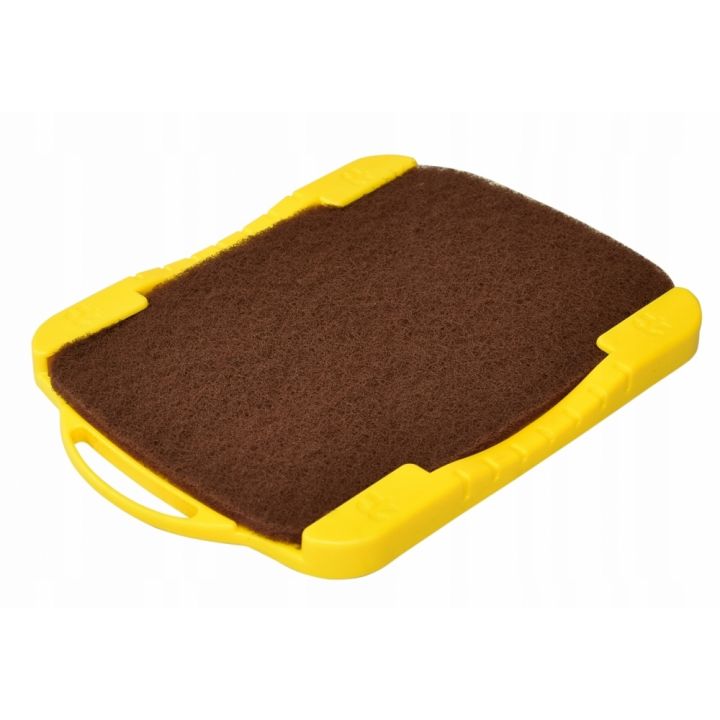 Cleaning mat for the soleplate
Cleaning mat for the soleplate Liquid cleaners
Liquid cleaners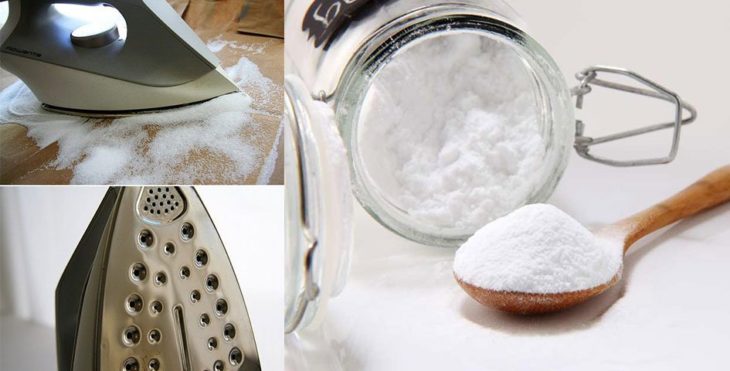 Soda and salt
Soda and salt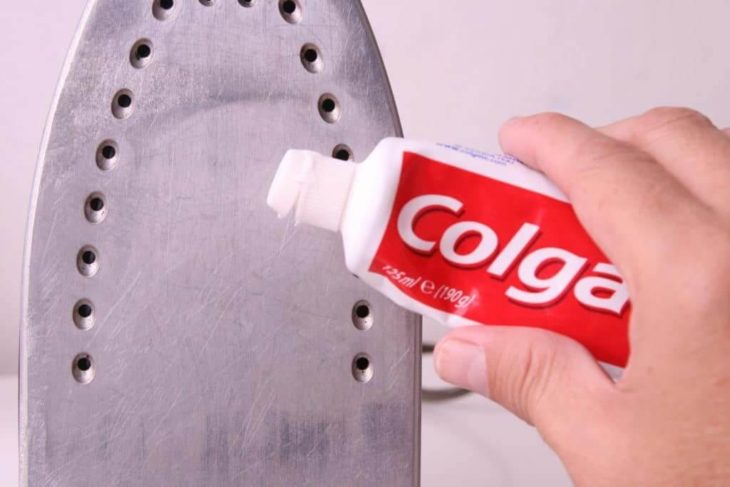 Toothpaste and tooth powder
Toothpaste and tooth powder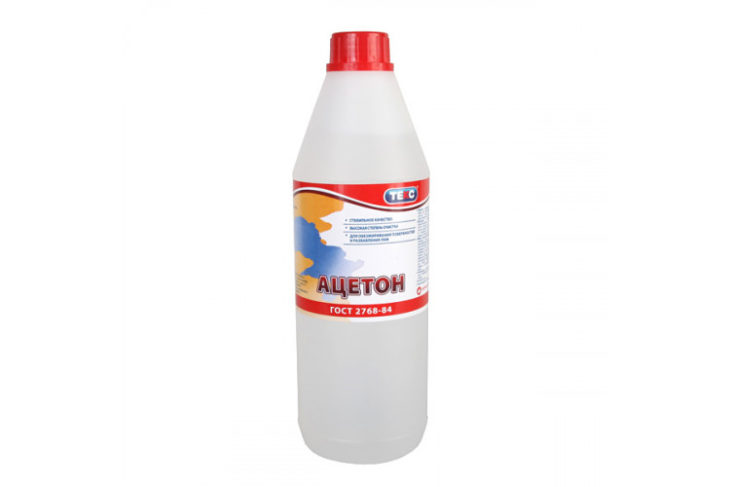 Acetone and nail polish remover
Acetone and nail polish remover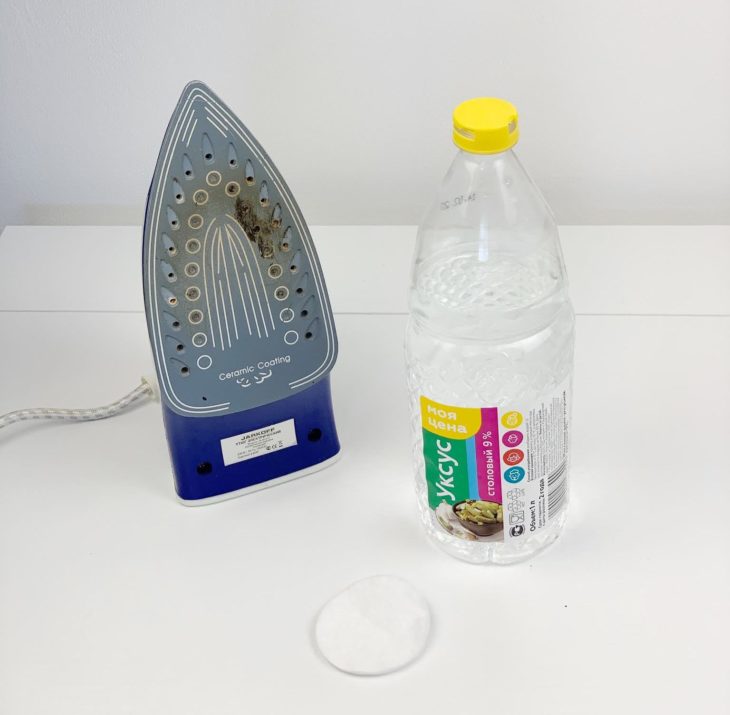 Vinegar
Vinegar Ammonia
Ammonia Laundry soap
Laundry soap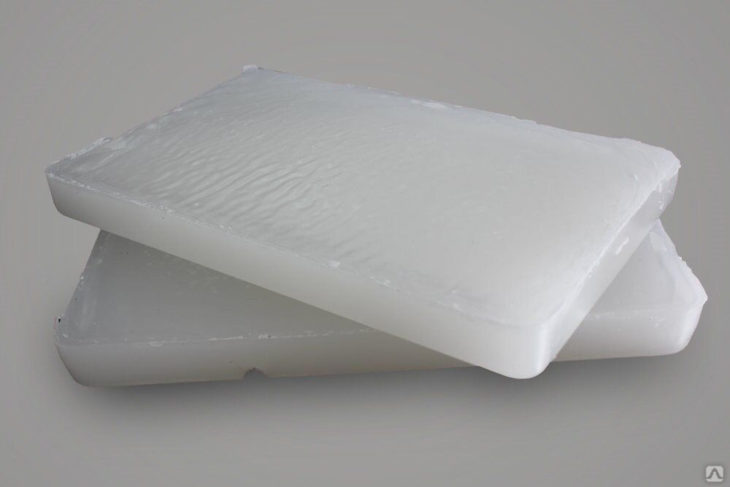 Paraffin
Paraffin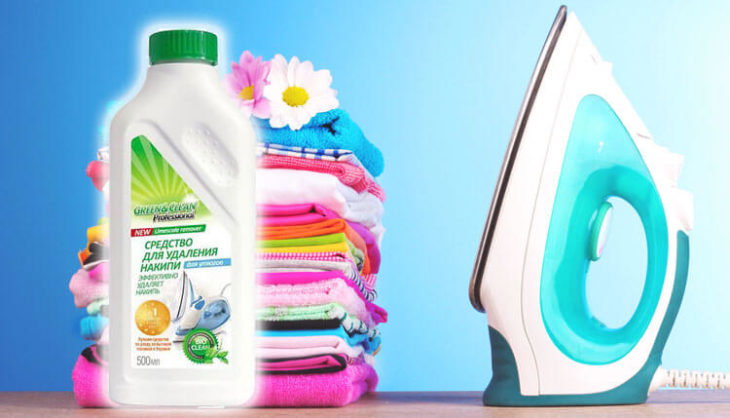 Clearing scale inside the iron with a special liquid
Clearing scale inside the iron with a special liquid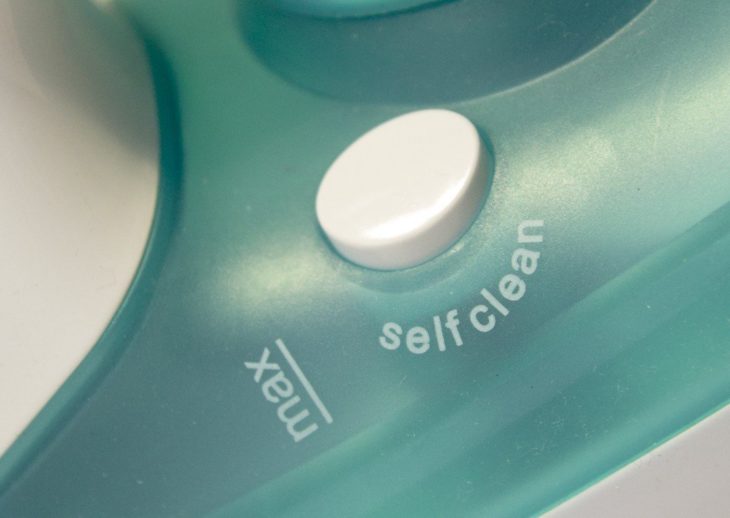 Iron self-cleaning function
Iron self-cleaning function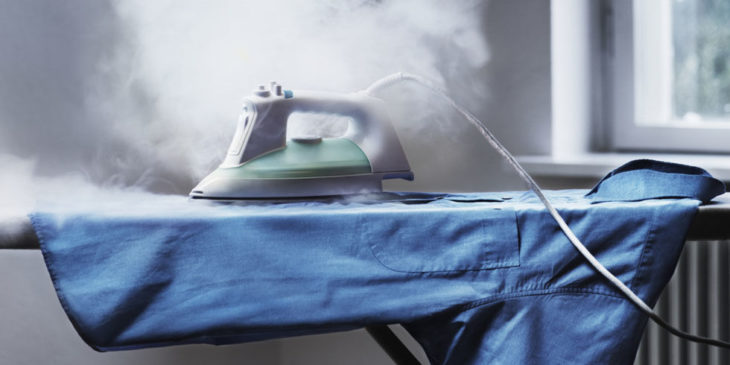 Precautions for cleaning the iron with various products
Precautions for cleaning the iron with various products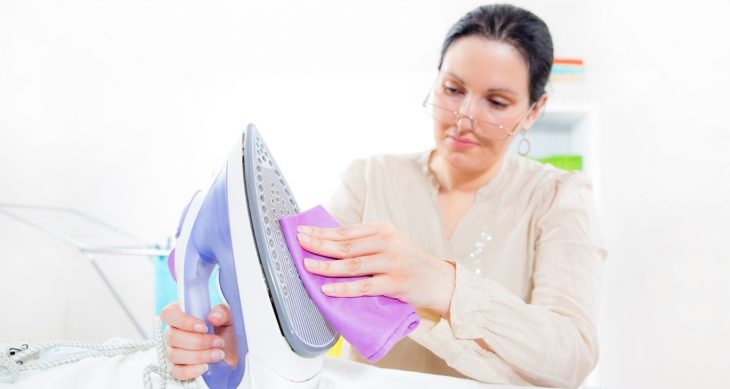 Prevent your iron from getting dirty
Prevent your iron from getting dirty